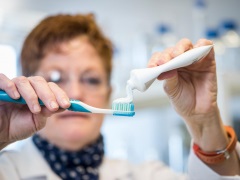Features
Bath bioplastics offer clean alternative
Date: 2017-06-16 14:47:49.0
Author: Jon Evans

Toothpaste can contain tiny plastic
microbeads, as demonstrated by Janet
Scott at the University of Bath.
Photo: University of Bath.
Researchers at Bath University in the UK have come up with two new, and quite different, ways to replace conventional plastics with bio-based alternatives. The first involves producing polycarbonate from sugars and carbon dioxide, while the second involves replacing the plastic microbeads found in shower gels and toothpaste with biodegradable versions made from cellulose.
Not only is polycarbonate used in the production of consumer products such as bottles and CDs, but being biocompatible it is also used in many medical applications, including as an implant material. The downside to polycarbonate, however, is that its current production process is far from ideal. This is because it usually involves reacting bisphenol A, which is currently banned in baby bottles in the US and the EU over health concerns, with phosgene, a highly toxic substance used as a chemical weapon in the First World War.
Antoine Buchard and his colleagues at the University of Bath have now come up with a new and improved production process that is both greener and safer, which involves reacting ribose-based sugar molecules with carbon dioxide at low pressures and room temperature. The secret is using an organic base to promote the reaction between carbon dioxide and the ribose sugar molecule. This converts the ribose into cyclic carbonate monomers, which can then be joined together via ring-opening polymerization to produce a bio-based version of polycarbonate.
As the researchers report in a paper in Polymer Chemistry, this bio-based version has the same properties as conventional polycarbonate, being strong, transparent, scratch-resistant and biocompatible. Unlike conventional polycarbonate, however, it can be readily broken down by soil bacteria. Buchard and his colleagues have shown that their new process works with both deoxyribose and thymidine 2’-deoxyribonucleoside, both of which are components of DNA.
The properties of the bio-based polycarbonate can also easily be expanded by combining it with other polymers or chemically modifying it. "For example, we can make the plastic positively charged so that cells can stick to it, making it useful as a scaffold for tissue engineering," said team member Georgina Gregory.
The other team of Bath researchers, led by Janet Scott, took a very different approach when trying to develop bio-based versions of the plastic microbeads used in shower gels and toothpaste to give them a smooth texture and enhance their cleaning action. The problem with these plastic microbeads, which are usually made from polyethylene or polypropylene, is that they obviously get washed straight down the drain. Because they are too small to be removed by sewage treatment processes, they can make their way into rivers and oceans, where they are ingested by birds, fish and marine life.
Hence the need for bio-based versions that will quickly break down once out in the environment. As Scott and her colleagues report in a paper in ACS Sustainable Chemistry and Engineering, the process they came up involves forcing a solution of cellulose through small pores, around 10μm in size, in the walls of a glass tube. This causes the cellulose to form small droplets that are carried away by vegetable oil flowing through the glass tube; adding a compound known as an antisolvent to this oil causes the droplets to set into hard beads, which can then easily be extracted.
"We've developed a way of making microbeads from cellulose, which is not only from a renewable source but also biodegrades into harmless sugars,” says Scott. "We hope in the future these could be used as a direct replacement for plastic microbeads." But that’s not the only use for these biodegradable beads, because they could also be impregnated with agrochemicals to produce slow-release pesticides and fertilizer.
The views represented here are solely those of the author and do not necessarily represent those of John Wiley and Sons, Ltd. or of the SCI.
This article has not been tagged with keywords.
